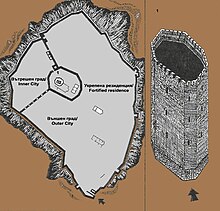Dorkovo
Dorkovo
Дорково Dorcova | |
|---|---|
Village | |
UTC+3 (EEST ) | |
| Postal Code | 4641 |
Dorkovo (Bulgarian: Дорково; Aromanian: Dorcova[2]) is a village in the Rakitovo municipality, Pazardzhik Province, western Bulgaria. The population of the village is 2,955. Aromanians live in the village.
Geography
Dorkovo is situated in the western Rhodope Mountains on the two banks of the river Matnitsa in the north-eastern parts of the Chepino Valley. It is located at the southern foothills of the Karkariya ridge which is part of the Batak Mountain.
The closest settlement is the small town of Kostandovo at only 3 km to the south. Further in southern direction is situated the municipal centre Rakitovo, while Velingrad the largest town in the area is at 14 km to the south-west.
Demographics
Members of the small Aromanian minority of Bulgaria live in Dorkovo, with this village being one of the few places in the country with an Aromanian community.[3][4]
Public institutions
Chitalishte
The chitalishte of the village is called St St Cyril and Methodius and was established in 1919 and initially used the edifice of a local cafe. The chitalishte was officially inaugurated in 1927 and moved to its own building in 1928. It was demolished on 3 August 1958 and a new two-storey edifice was constructed by December 1962. It has a cinema saloon with 300 seats, dressing rooms, rehearsal saloon and a modernised library. There are three amateur groups to the chitalishte.
Ovcharska Pesen Ensemble
The Ovcharska Pesen (Shepherd's Song) folklore ensemble to the chitalishte was founded in 1971. It consist of an orchestra, dancing group, male and female singing groups. The number of people varies between 45 and 120. The ensemble uses traditional Bulgarian musical instruments from the Rhodopi region -
.Landmarks

Tsepina fortress
The medieval fortress of
Between 1246 and 1254 Tsepina was occupied by the Nicaeans but was recovered by Emperor
Paleontological site
There is a
The site was discovered in the 1970s during search for mineral resources. The first scientific expedition was organised in 1984 followed by an international one in 1985 in cooperation with Collège de France which discovered parts of mastodon skeletons.
The site was declared a natural landmark on 31 January 1990.
Some fossil
Footnotes
- ^ "Bulgaria Guide, Rakitovo". Retrieved 29 January 2010.
- ^ Revista NOI ARMÂNJI, Nr.20-Cireshar2013, Sofia, Bulgaria (in Aromanian).
- ^ Constantin, Marin (2014). "The ethno-cultural belongingness of Aromanians, Vlachs, Catholics, and Lipovans/Old Believers in Romania and Bulgaria (1990–2012)" (PDF). Revista Română de Sociologie. 25 (3–4): 255–285.
- S2CID 144939846.
